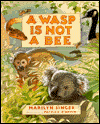
Published by Henry Holt& Co.
Available in hardcover in many libraries and bookstores.
If you cannot find it locally, you can order it directly from Amazon.com, the Internet bookseller. Amazon.com's listing also includes size, age range, card catalog entry and a larger picture of the cover by clicking on their "thumbnail" image.
To view Amazon.com's listing, please click this logo:
The insect trying to eat your ice-cream cone may look like a bee, but it's probably a yellow-jacket wasp. Some bees and wasps look similar, but they have many differences. Bees are usually hairy. Wasps are smooth. Most bees can carry pollen on their legs. Wasps can't. The honeybee, which is often confused with the yellow jacket, eats only pollen and nectar. Yellow jackets eat insects and other animals, which they feed their young, and sugary foods like fruit, soda, and your ice-cream cone.
Social bees, such as the honeybee, which live in hives built out of wax, make honey. Social wasps, such as the yellow jacket, which live in nests they make out of paper or other materials, do not. A beehive has many workers and one queen to lay eggs. The queen bee never leaves the hive. A wasp's nest has several queens, and they do leave to hunt food for the young wasps.
To protect their colonies,
bees and wasps can both sting. But wasps are usually
quicker to do so than bees. One reason for this may be
that a honeybee dies after it stings you. But a yellow
jacket does not. It can continue to sting you in several
places. That's good for the wasp, but not for you.
Copyright © 1995 by Marilyn Singer
[Marilyn Singer Home Page] [Bibliography]